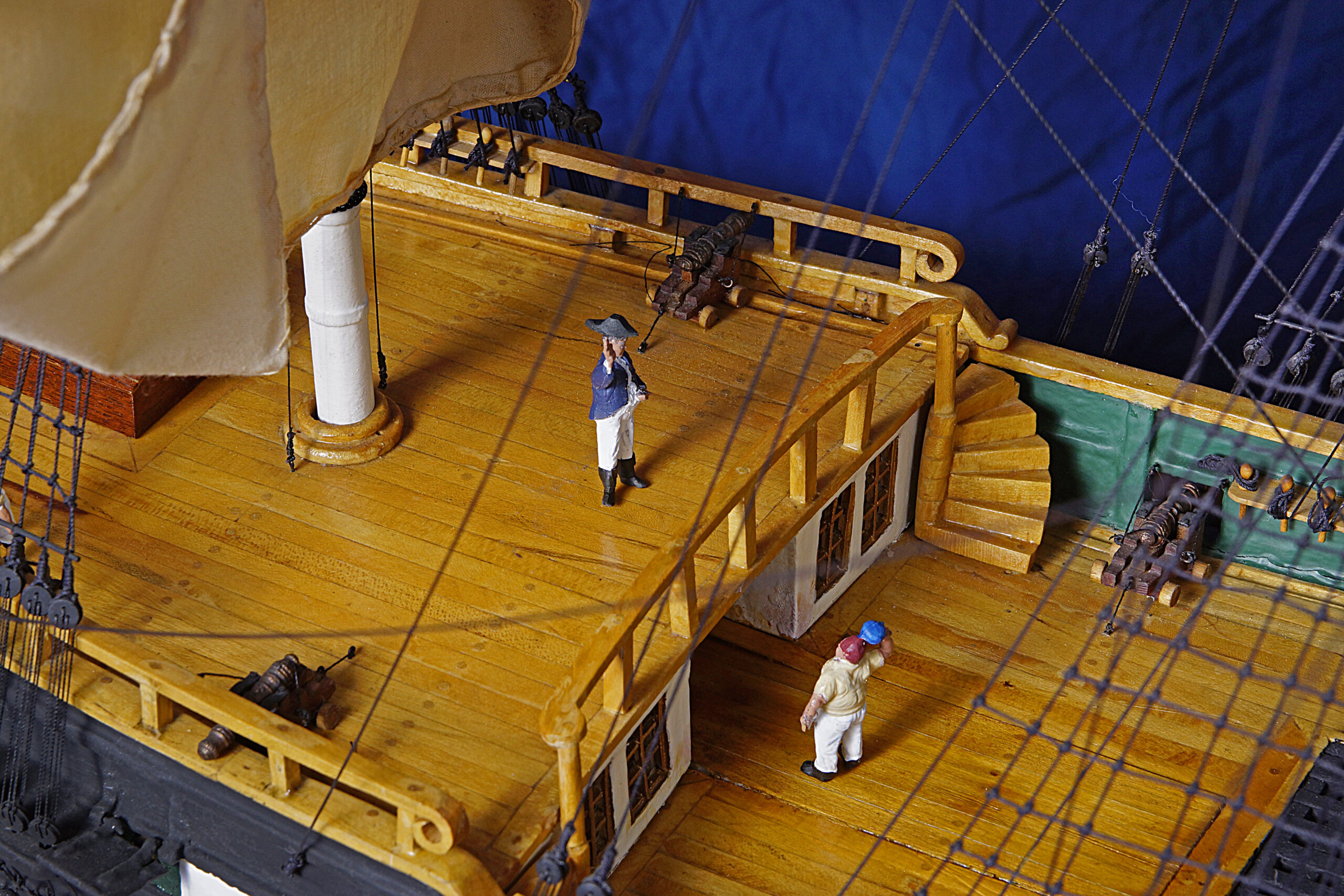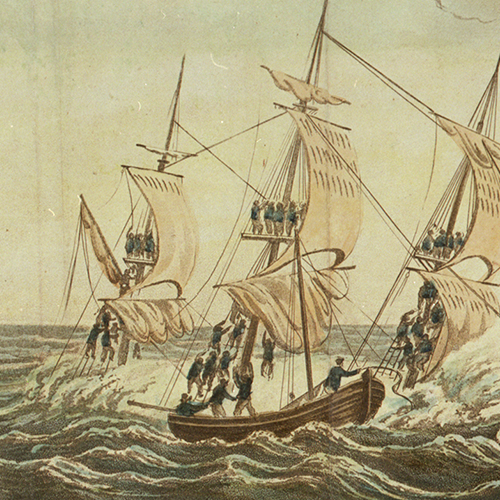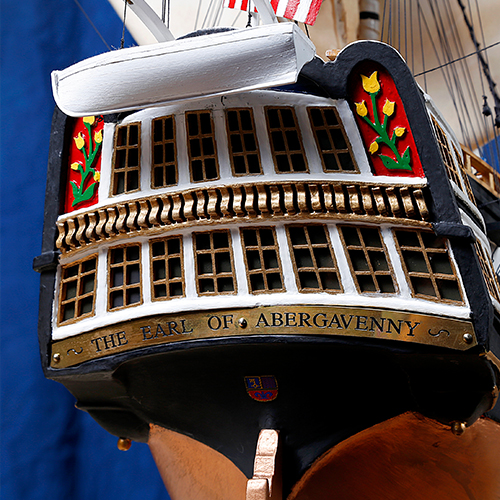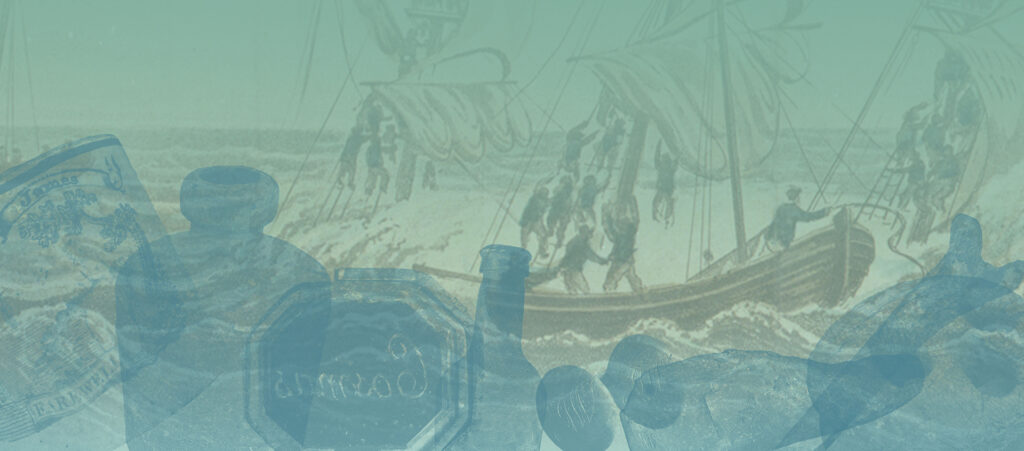An Interesting scene on board an East Indiaman, showing the Effects of a heavy Lurch, after dinner. George Cruikshank. National Maritime Museum, Greenwich, London.
Bread & Board
The entire trip from Portsmouth to Bengal and China was estimated to take 10 months. Quantities of food and drink to meet the needs of the crew and passengers would be carefully calculated, obtained and loaded in Gravesend before the ship’s departure.
The Earl of Abergavenny was first and foremost a trading ship. The purpose of its design was to meet the needs of the East India Company investors, maximising space for goods to be transported in the cargo holds and traded across south and southeast Asia. Although trade was its primary function, East Indiamen would be well armed should engagement with pirates or national enemies arise. That said, depending on weather conditions, they were well known as being slow to sail and manoeuvre.
Walking Larders
Kept on the poop deck of the ship would be livestock to be butchered on board in order to maintain adequate, quality stocks of meat for the high ranking passengers and crew. In the hold, towards the bow, would be barrels of salted beef and pork for their lower ranking counterparts. The sheer number of sheep, cows, pigs and poultry accommodated on East Indiamen led to descriptions of the ships as ‘floating farmyards’. One can only wonder at the variety of smells and sounds that would have drifted into the cabins located in the roundhouse. The rooftop of the roundhouse was the poop deck and the cabins were often separated by just canvas dividers.
Photograph by John Buckingham. The College of the Holy Cross
Sustenance
Rich & Poor
Dining on board could be a pleasant affair for the higher ranking passengers and crew. For those invited by the captain to his table, the main meal of the day would take place at 2:00 p.m. The menu of an East Indiaman similar to the Earl of Abergavenny and in service at the same time was recorded to include, ‘.. pea soup, roast leg of mutton, hogs’ puddings, two fowl, two hams, two ducks, corned round of beef, mutton pies, mutton chops, stewed cabbages and potatoes, followed by an enormous plum pudding and washed down with porter, spruce beer, port, wine, sherry, gin, rum..’ Games would be played after dinner and there was also music as entertainment. The female passengers would enjoy less freedom than the men, being confined to their cabins for a larger proportion of the time and restrictions placed on the quantity of wine they were permitted to drink.
In contrast to the food provided for the wealthier passengers and officers, English sailor, Samuel Kelly, in 1781 described the barrels of pork supplied to a ships’ crew as being ‘.. of infamous quality..’, going on to write that they ‘.. consisted of pigs’ heads with the iron rings in the nose, pigs’ feet and pigs’ tails with much hair thereon.’
Service
Conditions
On board the Earl of Abergavenny (and accounts vary) were, approximately, 160 crew, 160 troops and 80 passengers, 32 of whom were recorded as Chinese. Nationalities of crew members were recorded as Irish, American, Danish, Russian, Prussian, Italian, Portuguese, Swiss, German, Chinese and ‘Creole’. Although there were three women recorded as passengers, there is evidence that, as was the case with many ships, there were also women and children on board who were unrecorded, probably family members of the crew. Living conditions for soldiers, crew and their families would have been extremely cramped with all these groups being herded together in the same space. If this wasn’t difficult enough, then at night, lights were extinguished and silence ordered to avoid any possible attention from passing enemy ships.
Labour
The wide variety of jobs carried out by the crew included butcher, baker, cook, carpenter, sailmaker, surgeon, armourer and cauterer, to name but a few. An idea of the hard manual labour carried out by seamen can be seen in the bone analysis of a humerus excavated from the Earl of Abergavenny. The bone showed signs of enhanced development of the pectoral ridge suggesting larger than average upper arm strength, which would result from repeated lifting or pulling of ropes.
Discipline
Unruly behaviour from the crew, such as drunkenness, insolence or violence was common and would have been dealt with by means of lashings or striking in irons, amongst other forms of chastisement. Captain John Wordsworth recorded ordering these very forms of punishment in the logs of previous Earl of Abergavenny journeys as well as performing ‘Divine Service’ on Sundays when the weather allowed.
Survival
Labour in Vain
After the Earl of Abergavenny struck the Shambles at 5:00 p.m. on the 5th February 1805, the troops on board assisted the ship’s carpenter and his team at the pumps in the desperate race to rid the ship of the enormous quantities of water she was taking on. Repeated, violent strikes of the ship’s hull against the sandbank, caused by the tides and stormy weather, meant that the troops and crew were continually engaged in the Sisyphean task set before them for a period of around six hours. Urged on by their comrades, they worked tirelessly to keep at bay the continuously rising water level despite many suffering from severe seasickness.
Course of Action
The captain had planned to sail for the relative safety of Weymouth Sands when the ship came free of the Shambles. When it became apparent that the Earl of Abergavenny was taking on too much water, the ship’s cutter, carrying East India Company despatches, was launched in the hope that the men aboard would find help from the shore or from the other ships in the convoy. However, none was forthcoming.
Another small party managed to leave the ship when a nearby vessel sighted the ship’s distress signals. A senior East India Company merchant, his daughter and niece were rescued by a small skiff the vessel had sent to aid them.
Life & Death
As the ship reached the point of no return, some of the passengers and crew threw themselves into the sea, grasping at animal coops and pieces of wreckage to keep themselves afloat. Some climbed up into the shrouds, clinging to the masts that remained above the water level. When rescue boats eventually arrived, amongst the chaotic conditions, the remaining survivors were able to board and allow themselves to be taken to the safety of the shore. In the aftermath of the sinking, a few survivors shared the harrowing accounts of their experiences with various publications of the day and an official Company enquiry followed. The bodies of the drowned, including that of the captain, were buried together at Wyke Regis Church in Weymouth.
For further reading:
John Wordsworth and the wreck of the Earl of Abergavenny, Ed Cumming
The Wreck of the Abergavenny, Alethea Hayter
Deep Distresses, Richard E Matlak
Wordsworth: A Life, Juliet Barker
To see 3D digital models of finds excavated from the Earl of Abergavenny click here
Look in detail
Take a tour of some of our objects available to view in fabulous 3D! These images have been scanned by our volunteers who will be adding to the archive as the project continues.
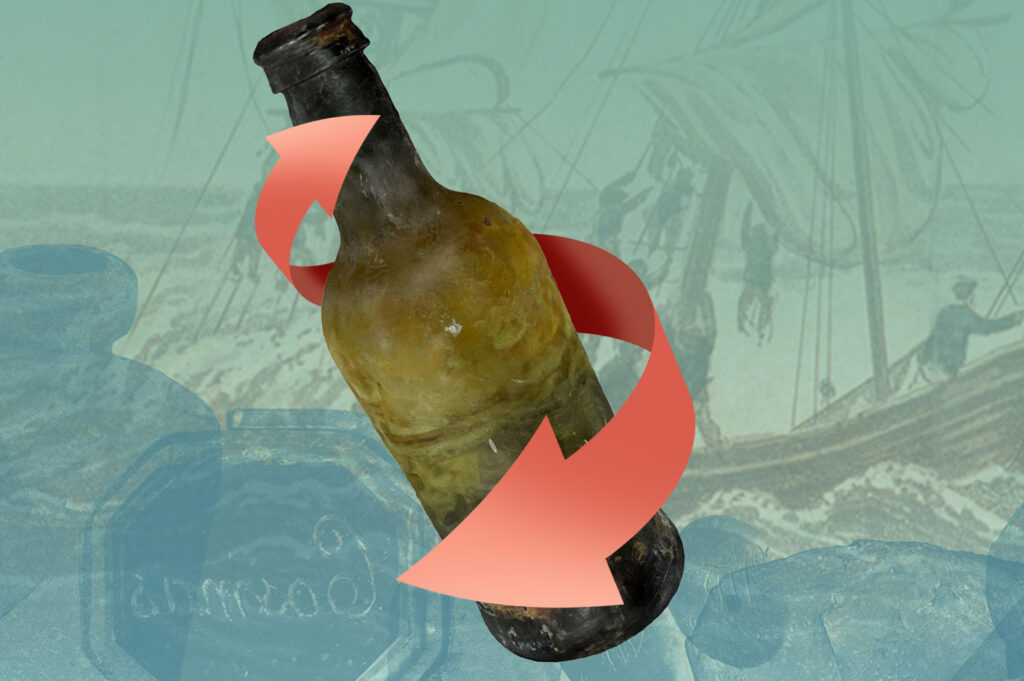
In November 2021, Portland Museum won a National Lottery Heritage Fund grant to launch a digital volunteering initiative and break down barriers to heritage. Working with partners, MSDS Marine and MSDS Heritage and the Nautical Archaeology Society, the museum is training volunteers in digital recording techniques to share 3D images and information on the finds from the Earl of Abergavenny shipwreck with the wider community.





